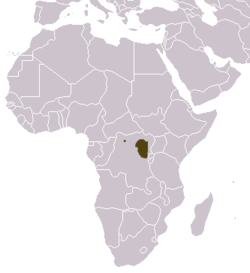| Aquatic genet | |
|---|---|
 | |
| Scientific classification | |
| Kingdom: | Animalia |
| Phylum: | Chordata |
| Class: | Mammalia |
| Order: | Carnivora |
| Family: | Viverridae |
| Genus: | Genetta |
| Species: | G. piscivora [2] |
| Binomial name | |
| Genetta piscivora [2] (Allen, 1919) | |
 | |
| Aquatic genet range | |
The aquatic genet (Genetta piscivora), also known as the fishing genet, is a genet that has only been recorded in the northeast of the Democratic Republic of the Congo. [3] [4] Since it is only known from about 30 specimens in natural history museums, it had been listed as Data Deficient on the IUCN Red List since 1996, as it is considered one of Africa's rarest carnivores. In 2015, it has been reassessed as Near Threatened. [1]
Contents
- Characteristics
- Distribution and habitat
- Ecology and behavior
- Threats
- Conservation
- References
- External links
When Joel Asaph Allen described the aquatic genet as a new genus and species in 1919, he named it Osbornictis piscivora. [5] It was reassessed in 2004, and based on molecular evidence is now considered a Genetta species. [6]
